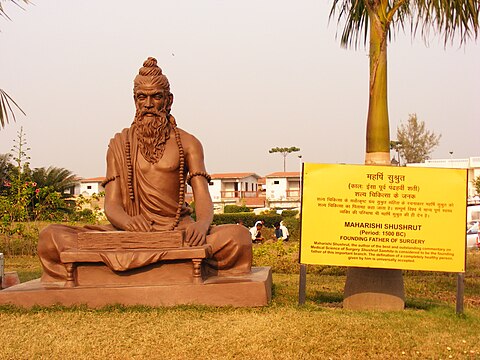Sushruta Samhita
From Wikipedia, the free encyclopedia
The Sushruta Samhita (सुश्रुतसंहिता) is a Sanskrit text on surgery, attributed to Sushruta, a physician who possibly resided in Varanasi around 6th century BCE.[1][2][3]
The text (based on analysis of ancient Indian manuscripts)[clarification needed], was likely composed around 3rd or 4th century BCE. It is one of three foundational texts of Ayurveda (Indian traditional medicine), alongside the Charaka Samhita and the medical portions of the Bower Manuscript.[4] The text has been edited multiple times by various practitioners of Ayurvedic medicine. At the end of several chapters, ancient sanskrit texts themselves explicitly declare that they have been supplemented, edited, and partially rewritten by later authors.Template:References requiredThe text was translated to Arabic as Kitab-i-Susrud in the 8th century CE.
Authorship [edit]
Suśruta (Devanagari सुश्रुत; a name literally meaning "well-famous") was an early Indian physician, who likely lived in Varanasi in the 6th century BCE.[5] Little is known about the historical character. The earliest known mention of the name is from the Bower Manuscript, which is dated to the 4th or 5th century CE where Sushruta is listed as one of the ten sages residing in the Himalayas.[6][6] It is thus not entirely certain that Sushruta is a historical figure, but most scholars tend to allow for the possibility that he was.[clarification needed] Later Ayurvedic texts present him a son of Vishvamitra or a descendant of Dhanvantari, the physician of the gods in Hindu mythology.[7]
Rao (2005) speculates that there may be an original "layer" to the text which may indeed date to the "elder Sushruta" (Vrddha Sushruta) which was redacted "by another Sushruta in the first century A.D." and still later additions and redactions by Nagarjuna (3rd century). The redaction by Nagarjuna is explicitly mentioned by Dalhana, the author of the primary commentary on the Sushruta Samhita.[8]

No comments:
Post a Comment